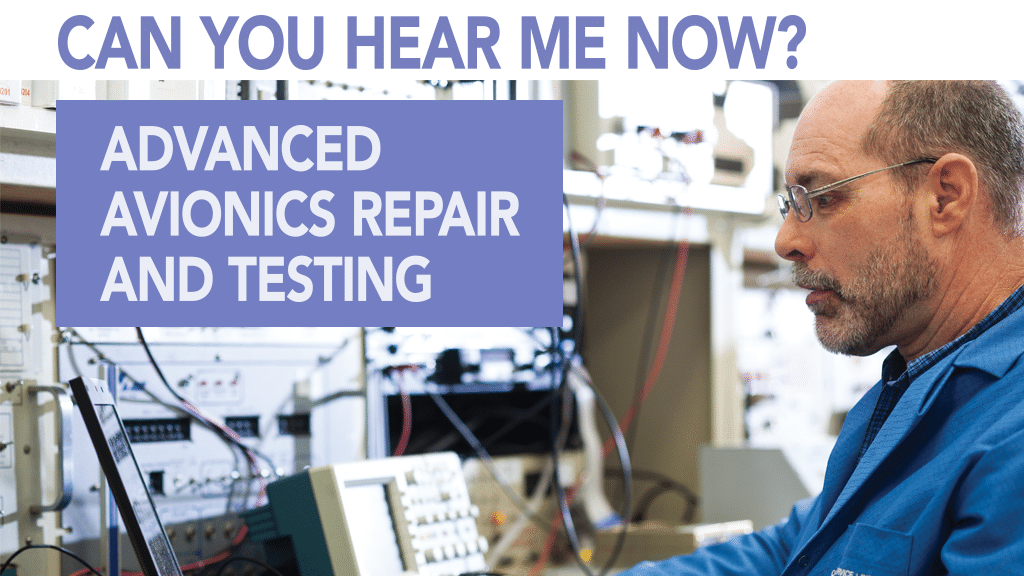Repairing and testing avionics systems ensures they are in good condition and working as intended to keep aircraft flying safely.
By Mark Robins
Avionics repair and test equipment and procedures are integral to maintaining the reliability, efficiency, and safety of aviation operations. A wide spectrum of sophisticated equipment and tools can diagnose and troubleshoot issues and conduct necessary repairs or replacements to ensure the optimal functioning of aircraft electronics. They can help detect and fix wear, damage or malfunction in the avionics components, wiring, connectors, antennas and software via manufacturers’ specifications and the regulatory standards. Aviation Maintenance spoke to several leaders in avionics repair and test equipment to take the pulse of this niche market.

SVP Operations, AJW Technique
“Repairs and testing procedures involve maintaining and troubleshooting intricate electronic components such as radio and communications systems, radar systems, flight management computers, autopilot and navigation systems,” says Louis Mallette, president, AJW Technique, Montréal, Canada. “These activities help identify and rectify any malfunctions or discrepancies in avionics systems ensuring they operate at optimal levels.”
Avtech, previously in Miami, was amalgamated with Muirhead Avionics at a new facility near London Heathrow (LHR) in the UK late last year. Both are part of the larger Ametek MRO, a global MRO services provider to the commercial, regional and general aviation aftermarkets with 12 locations around the world. Muirhead Avionics specializes in avionics services including MRO, sales, modifications and flight recorder transcription. “Muirhead Avionics continue to seek strategic partnerships with OEMs to support overflow, customer service, reach and global coverage,” says David Bentley, division vice president and business unit manager. Bentley also says Muirhead’s strong relationships with its current channel partners ensures OEM training, approved test equipment, up-to-date software/adapters, shared technical data as and when it is new and OEM spares.
“The recent move of Muirhead Avionics and Avtech to Langley near LHR allows us to tap into a large catchment area being close to the international airport and also the UK’s arterial road network,” Bentley says.
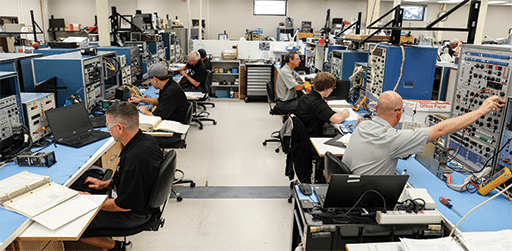
Repair and Testing Procedures
Avionics testing is generally done using automated test equipment (ATE) in which the equipment undergoes a full functional test. This can highlight specific failure areas in the component and then record necessary data, noting failures or routine operations. Automated testing can be completed in a fraction of the time it takes to complete manually, freeing up a technician’s time to work on other units.
“At our FAA Part 145 Repair Station, we utilize ATE to assess and validate the effectiveness of repairs,” says Dror Yahav, chief executive officer, Universal Avionics, Tucson, Ariz. “Our advanced surface mount technology rework processes ensure top-notch quality in the repair of circuit card assemblies (CCA). Previously, technicians performed tests and board repairs manually, which takes longer to complete, requires more training, and has a higher risk of human error. The introduction of automated testing and cutting-edge CCA rework technology has significantly enhanced our capacity to respond to customer repair orders while guaranteeing safety through effective repair services.”
Lincoln, Neb.-based Duncan Aviation’s avionics technicians troubleshoot avionics units based on experience and knowledge. With decades of hands-on experience, they can see trends, know which units or components within the units have a high failure rate, and often perform preventive maintenance.
Component Services bench technicians.
Electronics troubleshooting takes years of experience to master, according to Dustin Johnson, assistant manager component services at Duncan Aviation. “Avionics repair is one of the few electronics areas performed mainly by manually troubleshooting down to a component level and then having that mechanical or electronic component replaced by a trained electronics technician,” Johnson says.
It all starts with troubleshooting,” Johnson says. “Before any repair or testing can occur, the cause of the squawk must be determined through the act of troubleshooting. Proper and effective electronics troubleshooting takes many years of experience to master. Avionics repair is one of the few electronics areas performed mainly by manually troubleshooting down to a component level and then having that mechanical or electronic component replaced by a trained electronics technician. Testing is always performed as per the component maintenance manual or approved procedure.”

Division VP, Muirhead Avionics
Muirhead’s Bentley adds, “Troubleshooting has evolved from highly experienced technicians, who can fault-find at the control board level, to automated fault finding. But the traditional skills still play a key role, no matter how good the ATE is.”
Primary aircraft communication, navigation and surveillance (CNS) systems are some of the most common avionics components according to Matthew Harrah, senior vice president of technology and products for Mid-Continent Instruments and Avionics, Wichita, Kansas, that demand repair and testing. “This is everything from instruments and displays in the panel that provide the flight crew with critical information (attitude, airspeed, engine data, etc.) to navigation and communication systems such as VOR/TACAN receivers and radios to transponders/IFF systems that form the surveillance and air traffic control components at the aircraft. Each of these systems will have specific equipment for test and return to service, with the best example being Air Data test sets that measure absolute and differential pressure in air data systems (i.e., altimeters, vertical speed and airspeed indicators), which are typically thought of as pitot and static pressures.”
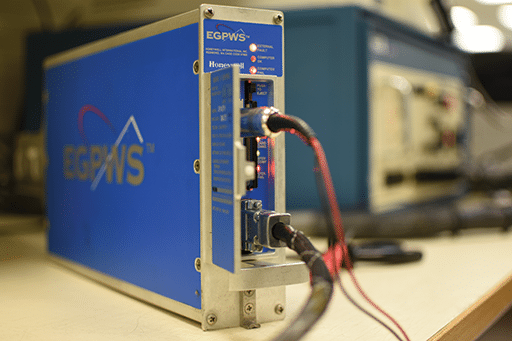
More Advanced
As today’s modern aircraft has become much more technologically advanced, so have the avionics repair and testing procedures and equipment that maintain it. Avionics components have evolved significantly over the years, progressing from principally analogue electronics in the 1980s to the latest digital technologies today with an increase of microprocessors embedded in aeronautics.
“As the world continues to evolve into a more digital event, automated testing has grown significantly,” Harrah says. “This has allowed avionics repair stations to access more data about the given component to improve the percentage of successful repairs in less time, while finding pending and latent failures that may not have been observable to technicians or flight crew.”
Mallette explains, “The testing of avionics components has become significantly more intensive, driven by new testing standards from the aircraft manufacturers and equipment OEMs to drive increased reliability and enhance safety on modern platforms. As an example, the number of test points performed during a typical avionics’ unit test is now easily 10 to 100 times what it would have been 20 years ago. ATE performance has clearly improved over the years and in conjunction with more efficient test software, has not increased the overall test time.”
Advanced and improved logging of flight log data from individual components has come with reduced memory cost and improved processing. Harrah says this has enabled more data to be recorded for post-flight analysis to improve overall dispatch reliability and reduce AOG issues by highlighting components that are in declining health/performance.
To increase efficiency, Duncan Aviation has invested in new testing and diagnostic technology that reduces the time it takes to evaluate a printed circuit board (PCB). This system evaluates PCB quality control and quickly diagnoses failures by identifying the areas of the board that are not functioning properly.
“Muirhead Avionics continues to embrace higher and more advanced technologies to improve our technicians’ technical ability to support repairs at every level and provide future partners with the confidence that [we] can handle the ever-evolving latest technological developments,” Muirhead’s Bentley says.

High Tech Out of Necessity
High-tech advancements have empowered maintenance personnel with innovative tools and techniques to ensure the continued reliability and safety of MRO operations and in so doing, of the aircraft operations. Avionics repair and testing has evolved in ways technicians could not have dreamed of even 20 years ago.
“There will be a tight labor market in the future, which will result in a large talent/recruitment gap at the OEMs,” says Bentley. “Therefore, via specialist partnerships AMETEK MRO has positioned itself all over the world to be able to provide avionics repair services that cater to the many technologies produced by OEMs. This helps the OEMs share the demand for component repair and overhaul, yet remain stable and retain control.”
Harrah explains that machine learning is a good first step toward artificial intelligence (AI). “It has been used to help analyze flight log data to help catch pending failures or degraded performance. AI is a logical next step beyond machine learning in analyzing avionics flight log data, including Built-In-Test (BIT), to better understand performance trends and enable more proactive replacement of components. This would reduce, and one day hopefully eliminate, scheduled interruptions and AOG events.” Johnson predicts that as AI gets more intelligent it will become a great tool to quickly locate information for assistance in troubleshooting avionics systems and answering all types of questions.
“Muirhead Avionics is not looking at AI for repair as the OEMs’ component maintenance manuals are the technical bibles of any MRO,” says Bentley. “But we are looking into opportunities for spares linked to provisioning data,” he adds. “Watch this space.”
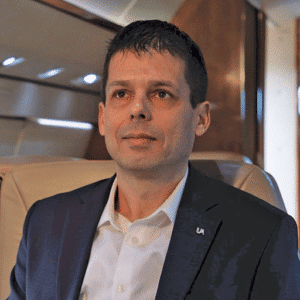
CEO, Universal Avionics
Universal Avionics’ second Grand Challenge competition encouraged employees across the organization to explore how Artificial Intelligence (AI) can be used to streamline the development of procedures. This resulted in not just one, but four unique projects being continued to transform operations with AI, from document generation to software testing and verification. This reflects on how the company leverages the latest technological advancements to enhance the quality of its services to ensure safety, efficiency, customer satisfaction and cost savings. “We are continuously implementing software improvements to support emerging products and leverage cloud technologies to further benefit from these advancements,” Yahav says.

SVP, Mid – Continent Instruments and Avionics
The Cloud provides a simplified means of putting the data in a location to be analyzed. It is significantly more accessible to aircraft data. Coupled with the evolution of systems that can pull data off the aircraft over the air (OTA), such as Wi-Fi, terrestrial communication systems like ATG, SATCOM or simple cellular modems, the Cloud has made the data both more accessible and, in many cases, able to be processed in near real time. Harrah says, “This is a major improvement to the days of ‘the sneaker-net’ where a technician needed to access a serial port, download data to a laptop, then email or upload and wait for human analysis. Today’s integrated maintenance systems can, in some cases, allow a technician to see the status of all avionics systems and many other aircraft systems almost instantly upon touch-down of the aircraft.”
Another significant repair advancement is using predictive maintenance techniques enabled by data analytics and machine learning algorithms. By analyzing vast amounts of data collected from aircraft sensors and systems, predictive maintenance can anticipate potential failures before they occur, allowing for proactive maintenance actions. This approach minimizes downtime, reduces maintenance costs, and enhances overall aircraft reliability.
While predictive maintenance is a growing trend, Mallette believes its adoption within the aviation industry varies significantly among different stakeholders, reflecting diverse levels of technological readiness and strategic approaches. “These challenges must be addressed to foster more collaboration and to achieve widespread adoption to the benefit of the industry.”
Mallette also notes the innovation of Augmented Reality (AR) and Virtual Reality (VR) has enabled AJW’s maintenance technicians to visualize complex systems and components in a virtual environment, facilitating training, troubleshooting and repair tasks. AR and VR also provide interactive step-by-step guidance during maintenance procedures, improving efficiency and accuracy while reducing human error.

A Repair and Test Digital Transformation
Digital transformation within avionics repair and test workshops has positively affected workflow management and efficiency during the repair process. At AJW Technique, due to digitalization, Mallette says the management of work orders, shop planning and scheduling, and parts pre-provisioning processes have all made great strides over the past few years. “Furthermore, BI (Business Intelligence) reporting provides a greater visibility of the factory performance at a macro level while also facilitating easy status visibility at an individual work order level. This has supported an improvement in overall efficiency and enables us to maintain short repair turnaround time cycles whilst optimizing technician capacity and inventory holdings.”
The digital age of avionics has impacted the level of skill and education needed by the technicians performing repairs and testing. Johnson says Duncan Aviation bench-level repair technicians receive two years of formal education specializing in electrical and electronic theory. “Even with the new advancement of digital technology, there will always be a demand for quality component-level work.”
Beyond the FAA Part 145 maintenance, repair, and overhaul facilities, Universal is supporting line maintenance technicians by employing mixed reality technology. One example is the use of Microsoft HoloLens for remote field support, which allows field technicians to quickly guide users through step-by-step solutions using a head-wearable device.
“By blending the digital world and the real world, our field service engineers can remotely support technicians with troubleshooting and testing of systems in the aircraft,” Yahav says. Universal engineers can virtually pass along documents that the remote technician can see inside the headset, all while discussing any issues and resolving problems in real-time. Fielding of this technology has been quite beneficial for our field service engineers, enabling them to assist multiple customers worldwide in configuring, testing, and troubleshooting aircraft avionics.”
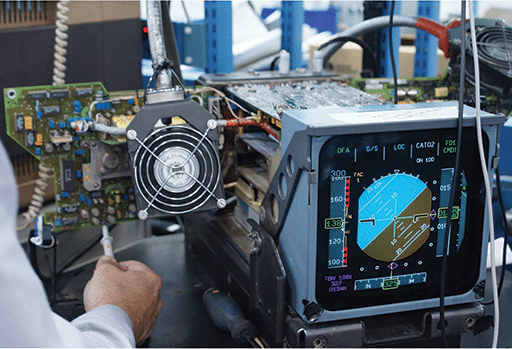
Repair and Test Obsolescence
Generally, repair and testing procedures remain similar throughout the life of the components. However, Mallette says, obsolescence, especially of electronics components, is a real issue both for the maintenance of the automated test equipment as well as for the avionics components.
Obsolescence is a significant problem, particularly post-Covid-19 shutdowns that had a major impact on supply chains. Harrah says many legacy component suppliers for piece-parts needed for repair were small and struggled to bridge the gap between Spring 2020 and 2021. “Therefore, a lot of the smaller suppliers went out of business. Those that did survive increased pricing as demand also started to increase. This has expanded into older test equipment as well. Many repair stations are looking at new test equipment, which in turn drives costs that must be addressed in repair pricing. Some manufacturers of avionics also started to accelerate the end of support due to the period of low demand in this same timeframe. That has left many legacy avionics beyond economical repair (BER). Some shops, like ours, have been able to develop some PMA parts replacements to enable older equipment to be serviced, as well as using our own engineering to sustain our test equipment.”
Yahav explains one challenge obsolescence presents within MROs is the need for procedural changes, which also requires updated documentation and training. “Industry advancements in technical publications include advanced digital standards and a common source database structure. We are also leveraging AI for documentation development, which ensures efficient and accurate implementation of procedural changes. Combined with the critical thinking and problem-solving skills of our avionics and electronic repair personnel, we can adapt to these changes quickly.”
An Exciting Field
Today’s technologically advanced world makes repairing and testing avionics an exciting field. It requires specialized training, an aptitude for critical thinking and people who can integrate the digital with the mechanical to solve problems. Yahav believes that while accurate procedures and technologically advanced equipment can improve efficiency and ensure quality, it is really the individuals doing the work that are crucial to the success of any MRO operation.
